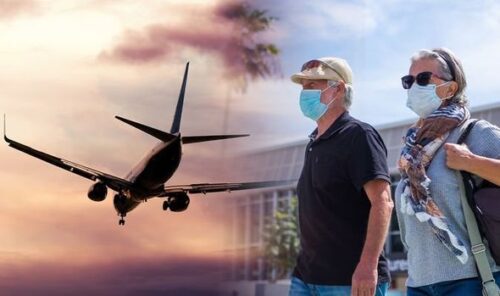A new military-led study unveiled Thursday shows there is a low risk for passengers traveling aboard large commercial aircraft to contract an airborne virus such as COVID-19 — and it doesn’t matter where they sit on the airplane.
While the more time spent on an aircraft correlates to a potential infection rate, according to the study, even passengers on long-haul flights wouldn’t be able to pick up a sufficient viral load under the test conditions.
Passengers traveling on board the 777 would need to spend at least “54 hours when sitting next to an index patient in the economy section,” and more than 100 hours in the other cabins of both the 777 and the 767 to be exposed to an infectious dose, the study said.
Pentagon study: Low risk of contracting COVID-19 on planes with passengers wearing masks
October 2020
The risk of contracting an airborne virus such as COVID-19 is very low when traveling aboard a large commercial aircraft when most people are wearing masks, according to a Defense Department-led study released Thursday.
A U.S. Transportation Command-backed study found that due to air particle filtration and ventilation systems, 99.99 percent of particles released into the air from an infected person wearing a mask were removed from the aircraft cabin within six minutes of being released.
Even if someone were sitting directly next to an infected passenger, 99.7 percent of the virus particles around them would be removed in that timeframe, the study found. That’s roughly 15 times faster than the particles would take to dissipate in an average home and five to six times faster than in a modern hospital.
The study concluded that it was “extremely unlikely” passengers would be exposed to an infectious dose of COVID-19 while on a 12-hour flight.
The Pentagon study — the largest aircraft aerosol experimental validation testing to date — took place over eight days of inflight and ground tests at the end of August on Boeing 777-200 and 767-300 planes.
Researchers said they used the Commercial Aircraft Cabin Aerosol Dispersion Test, which placed fluorescent markers on aerosol tracers to measure how long they remained in the air.
Mannequins, acting as infected passengers, were placed throughout the plane to simulate where the aerosols might be released from breathing or coughing, with and without masks.
More than 300 aerosol release tests were performed, according to the Pentagon.
Researchers also collected samples from “high-touch” zones and found that flat surface areas such as armrests are more likely to collect virus particle than vertical service areas such as video screens and seat backs.
The tests alongside DARPA and Air Mobility Command, as well as biodefense company Zeteo Tech, research company S3i and the University of Nebraska’s National Strategic Research Institute. Boeing and United Airlines were also industry partners.
The results of the study could give a boost to the commercial airline industry, which has been one of the hardest hit during the coronavirus recession. Major U.S. airlines started cutting thousands of jobs this month due to decreased demand.
Military.com by Oriana Pawlyk
October 2020

